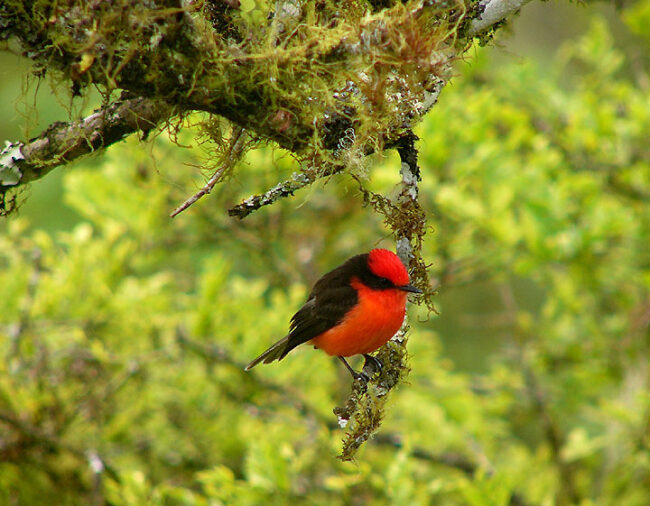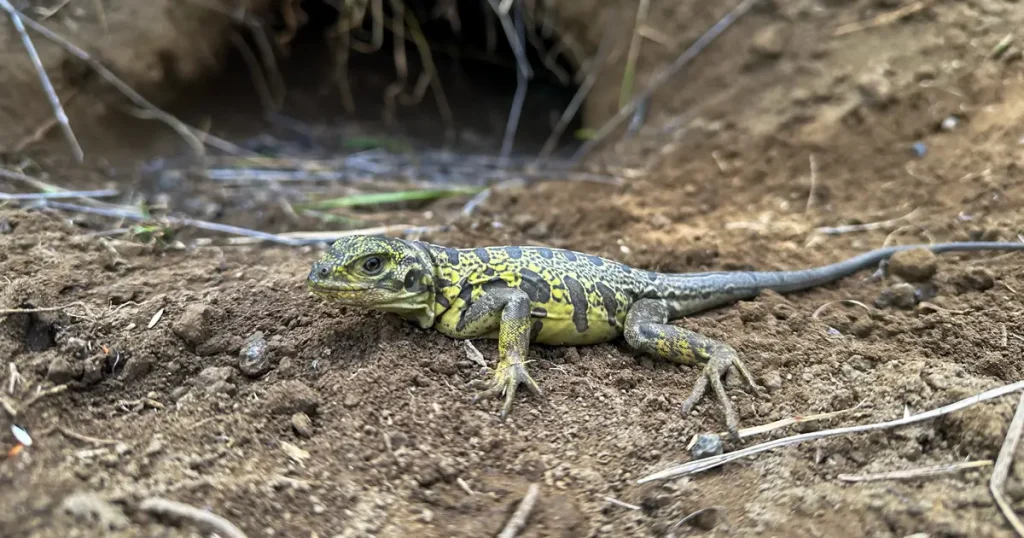New Research Guides Plan to Save Darwin’s Flycatcher on Santa Cruz
[Versión en español abajo]

Latest survey reveals a rising population of fledgling flycatchers on Santa Cruz Island.
With just over 30 individuals remaining, one of the most cherished and emblematic birds of the Galápagos Archipelago — the Darwin’s Flycatcher (Pyrocephalus nanus) — is at risk of disappearing forever from Santa Cruz Island. Although subpopulations of this landbird species, formerly known as the Vermillion Flycatcher, inhabit other islands in Galápagos, the dwindling numbers on Santa Cruz suggest the possibility of extinction in the near future.
The male Darwin’s Flycatcher, with its bright scarlet plumage and dark mask around the eyes, is one of the most striking birds in the Islands. On Santa Cruz, the remaining individuals are found mostly in the highest part of the island, living in the last remnants of native Scalesia forest, an endemic tree of Galápagos that is sadly dwindling primarily from the rapid spread of non-native and invasive plants, especially the Asia Blackberry (Rubus niveus).
With its natural habitat in decline, Darwin’s Flycatcher is also facing grave threats from the invasive and non-native Vampire Fly (Philornis downsi) whose larvae suck the blood from defenseless fledgling birds in the nest.

By analyzing their feeding behavior, scientists have identified the Asia blackberry as the cause of nutritional deficiency among both adults and their chicks. In many areas, the blackberry thickets are impenetrable for Darwin’s Flycatchers, which prevents them from accessing their main food source — spiders and caterpillars on the ground.
Over the past three years, Galápagos Conservancy, in collaboration with the Galápagos National Park Directorate, has partnered with researchers from the University of Vienna and the Charles Darwin Foundation to find ways to reverse the decline of the flycatcher population. The aim has been to save the flycatcher by reducing the number of Vampire Fly larvae, as well as control the presence of blackberry plants and rodents in their habitat.
To reduce the number of Vampire Fly larvae, a low-impact insecticide was infused into the base of active flycatcher nests — a methodology that has proven effective in reducing the prevalence of larvae in past conservation work.
Additionally, Galápagos Conservancy has funded the restoration of 15 acres of Scalesia forest on Santa Cruz where Darwin’s Flycatchers once thrived. This work has focused on eliminating dense thickets of Asia Blackberry, clearing non-native elderberry trees, and controlling rodents through the use of bait stations.
These experimental management techniques have already begun to turn the tide. Before the implementation of these measures in Santa Cruz, only two fledglings were recorded per year on average, but that number has now increased in consecutive years. Based on an exhaustive search of 13 miles of Scalesia forest in the areas of Los Gemelos, Mina de Granillo Rojo, and Cerro Crocker, scientists counted six fledglings in 2020 and eight in 2021, along with 33 adults.
Dr. Jorge Carrión, Conservation Manager of Galápagos Conservancy, noted “Decades ago, during a walk in the upper part of Santa Cruz, it was common to see Darwin’s Flycatchers but sadly now there are very few surviving individuals in this area. Therefore, research is essential to promote management measures to recover its population and its role in the Galápagos ecosystems.”
According to project leader Dr. Sabine Tebbich of the University of Vienna, “Permanent habitat management of the flycatcher is essential to save the species from extinction and this must be combined with continuous control of the avian vampire fly to stabilize the extremely small population of the flycatcher.”
An evaluation of the vegetation also revealed that the control of invasive plants stimulates the recovery of the flycatcher habitat through the natural regeneration of the Scalesia forest.
Currently, the flycatcher is listed as Vulnerable on the Red List of the International Union for Conservation of Nature (IUCN). With continued conservation action, we are confident the species can be permanently saved.
Nueva investigación revela pautas de manejo claves para recuperar la población del pájaro brujo en Galápagos
Con apenas unas 30 individuos de una de las aves más queridas y emblemáticas del archipiélago de Galápagos, el pájaro brujo (Pyrocephalus nanus), corre el riesgo de desaparecer para siempre de la isla Santa Cruz. Aunque hay poblaciones de esta ave terrestre en otras islas del archipiélago, la disminución del número de individuos en Santa Cruz sugiere la posibilidad de extinción en un futuro cercano.
El pájaro brujo macho destaca por el brillante color rojo de su cabeza y pecho, y un pequeño antifaz negro que lo convierten en una de las aves terrestre más llamativa del lugar. En Santa Cruz los últimos individuos del pájaro brujo están en la parte alta de la isla y viven en el último remanente de bosque de Scalesia, árbol endémico de Galápagos que también disminuye y está amenazado principalmente debido a la rápida propagación de especies no nativas y plantas invasoras, como la mora (Rubus niveus).
Además del hábitat natural, cada vez más reducido del pájaro brujo, la mayor amenaza para esta ave es la mosca invasora Vampiro Aviar (Philornis downsi), cuyas larvas chupan la sangre de las indefensas crías de las aves en el nido.
Por otro lado, al analizar el comportamiento alimentario de esta especie, los científicos han determinado deficiencia nutricional entre los adultos y sus polluelos, debido a la gran cantidad de plantas de mora que impiden el acceso a su alimento, principalmente arañas y orugas que están en el suelo.
En los últimos tres años, Galápagos Conservancy sumó esfuerzos con investigadores de la Universidad de Viena y la Fundación Charles Darwin, en colaboración con la Dirección del Parque Nacional Galápagos (DPNG), para buscar formas de revertir el declive de la población del pájaro brujo. Se busca reducir el número de larvas de la mosca vampiro aviar, y controlar la presencia de roedores y mora en su hábitat.
Para reducir el número de larvas de la mosca vampiro aviar, se aplicó una inyección con un insecticida de bajo impacto en la base de los nidos del pájaro brujo. Esta metodología ha sido previamente probada, brindando excelentes resultados para reducir el número de larvas.
Adicionalmente, Galápagos Conservancy ayudó en la restauración de 6 hectáreas del hábitat del pájaro brujo en el bosque de Scalesia en Santa Cruz, centrándose principalmente en la eliminación de especies invasoras, plantas de mora y árboles de sauco, y el control de roedores con cebos permanentes.
Estas técnicas experimentales de gestión empeizan a dar resltados prometedores, antes de la implementación de estas medidas en Santa Cruz, solo se registraban dos volantones en promedio por año, pero ahora ese número ha aumentado. En base a una exhaustiva búsqueda de 21 kilómetros de recorrido en el bosque de Scalecia, en las zonas de Los Gemelos, Mina de Granillo Rojo y Cerro Crocker, fueron encontrados 33 individuos adultos y ocho volantones de pájaro brujo, confirmando la efectividad de las medidas implementadas en su área de vida.
Jorge Carrión, Gerente de Conservación de Galápagos Conservancy mencionó que décadas atrás, durante una caminata en la parte alta de Santa Cruz era común reconocer al pájaro brujo por su particular vuelo. Sin embargo, ahora los pocos individuos remanentes sobreviven en un área muy restringida.” Por lo tanto, la investigación es primordial a fin de promover medidas de manejo para recuperar su población y su rol en los ecosistemas de Galápagos”, señaló Carrión.
La investigadora Sabine Tebbich de la Universidad de Viena, líder del proyecto, aseguró que “el permanente manejo del hábitat del pájaro brujo es esencial para salvar de la extinción a la especie y esto debe combinarse con el control continuo de la mosca vampiro aviar para estabilizar la extremadamente pequeña población de esta ave”.



